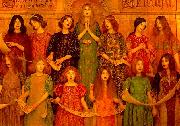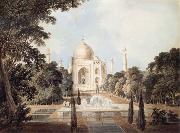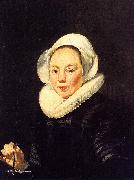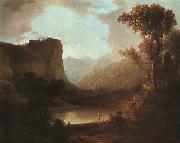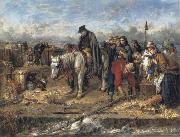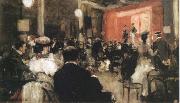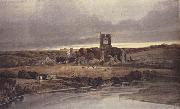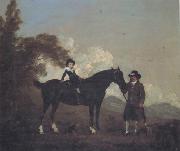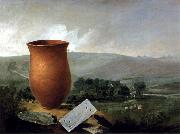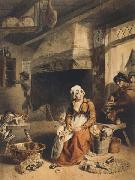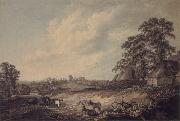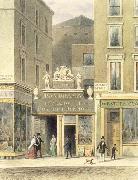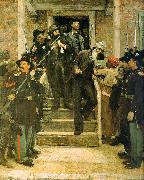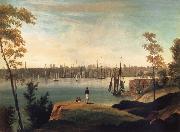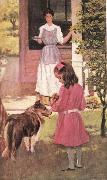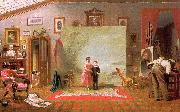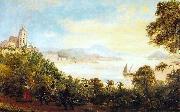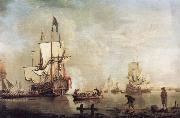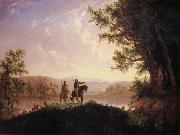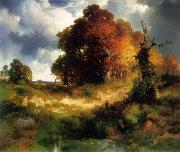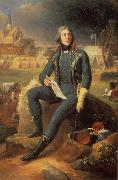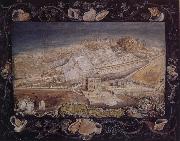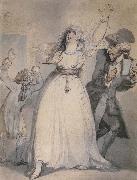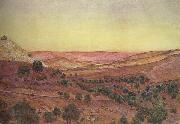|
|
|
|
|
|
|
|
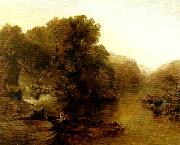 |
thomas creswick
|
|
Thomas Creswick (5 February 1811 - 28 December 1869) was an English landscape painter and illustrator, born in Sheffield, son of Thomas Creswick and Mary Epworth and educated at Hazelwood, near Birmingham.
At Birmingham he first began to paint. His earliest appearance as an exhibitor was in 1827, at the Society of British Artists in London; in the ensuing year he sent to the Royal Academy the two pictures named Llyn Gwynant, Morning, and Carnarvon Castle. About the same time he settled in London; and in 1836 he took a house in Bayswater. He soon attracted some attention as a landscape painter, and had a career of uniform and encouraging, though not signal success. In 1842 he was elected an associate, and in 1850 a full member of the Royal Academy, which, for several years before his death, numbered hardly any other full members representing this branch of art.
In his early practice he set an example, then too much needed, of diligent study of nature out of doors, painting on the spot all the substantial part of several of his pictures. English and Welsh streams may be said to have formed his favourite subjects, and generally British rural scenery, mostly under its cheerful, calm and pleasurable aspects, in open daylight. This he rendered with elegant and equable skill, color rather grey in tint, especially in his later years, and more than average technical accomplishment; his works have little to excite, but would, in most conditions of public taste, retain their power to attract.
Creswick was industrious and extremely prolific; he produced, besides a steady outpouring of paintings, numerous illustrations for books. He was personally genial, a dark, bulky man, somewhat heavy and graceless in aspect in his later years. He died at his house in Bayswater, Linden Grove, after a few years of declining health. Among his principal works may be named England (1847); Home by the Sands, and a Squally Day (1848); Passing Showers (1849); The Wind on Shore, a First Glimpse of the Sea, and Old Trees (1850); A Mountain Lake, Moonrise (1852); Changeable Weather (1865); also the London Road, a Hundred Years ago; The Weald of Kent; the Valley Mill (a Cornish subject); a Shady Glen; the Windings of a River; the Shade of the Beech Trees; the Course of the Greta; the Wharfe; Glendalough, and other Irish subjects, 1836 to 1840; the Forest Farm Frith for figures, and Ansdell for animals, occasionally worked in collaboration with Creswick. |
|
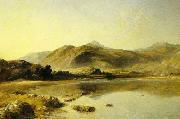 |
Thomas Danby
|
|
(c. 1818 - 25 March 1886) was an English landscape painter.
Danby was born, it is thought, in Bristol in south-west England, the younger son of Francis Danby (1793-1861). He had an elder brother, James Francis Danby (1816-75) who also became a landscape painter. Thomas went with his father to Europe in 1829, living for a time in Paris where he was able to earn a living by copying pictures at the Louvre in Paris. He thus became an earnest admireer and "student" of Claude Lorrain, whose aerial effects he sought to imitate.
Returning to England about the same time as his father, he first exhibited at the British Institution in 1841, and afterwards frequently at the Royal Academy from 1843. He was a friend of Paul Falconer Poole, with whom he shared a house in Hampstead in 1843, and imbibed not a little of his romantic feeling for nature. From 1855 to his death, Danby resided in or near Hampstead in north London..
The subjects of his landscapes were usually taken from Welsh scenery, especially the old county of Merioneth; his pictures for the most part were not ideal compositions (unlike his father's work) but actual scenes pervaded with a true romantic spirit. "He was always trying" says the writer of his obituary in The Times newspaper, "to render his inner heart's feeling of a beautiful view rather than the local facts received on the retina."
He came, it is said, within one vote of election as an Associate of the Royal Academy (ARA) but, failing eventually to attain Academy honours, he devoted himself in his latter years chiefly to watercolour painting. He became a member of the Royal Hibernian Academy in 1860, an associate of the Society of Painters in Watercolours in 1867, and a full member of the latter in 1870; until his death his contributions were prominent amongst the works at the society's exhibitions.
Danby died of a chest complaint, terminating in dropsy on 25 March 1886. He had been twice married, and had 2 daughters and a son from the second marriage.
|
|
|
|
|
|
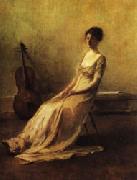 |
Thomas Dewing
|
|
(May 4, 1851 C November 5, 1938) was an American painter working at the turn of the 20th century. He was born in Newton Lower Falls, Massachusetts. He studied at the Acad??mie Julian in Paris, and later settled into a studio in New York City. He married Maria Oakey Dewing, an accomplished painter with extensive formal art training and familial links with the art world.
He is best known for his tonalist paintings, a sub-genre of American art that was rooted in English Aestheticism. Dewing's preferred vehicle of artistic expression is the female figure. Often seated playing instruments, writing letters, or engaged in other impassive actions and situated in gauzy, dreamy interiors, the figures remain remote and distant to the viewer. These scenes are infused with a color that pervades the entire picture, setting tone and mood. The ethereal delicacy and subtle color harmonies of Dewing's paintings have not met with universal approval: some feminist critics have lambasted Dewing's work as being misogynistic; he rarely painted anything other than the female figure, vacant of expression, languishing in sumptuous clothing.
Tonalism quickly came to be considered outdated with the advent of modernism and abstraction in art, though Dewing was successful in his own day. His art was considered extremely elegant, and has undergone a subtle revival in the last 10 years or so.
Dewing was a member of the Ten American Painters, a group of American Impressionists who seceded from the Society of American Artists in 1897. |
|
|
|
|
|
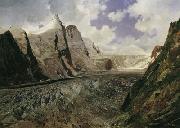 |
Thomas Ender
|
|
(3 November 1793 Vienna - 28 September 1875 Vienna) was an Austrian painter.
He was twin brother of Johann Ender. He also studied at the Vienna Academy, becoming a noted landscape painter. He won the grand prize at the Vienna Academy in 1816. Going to Brazil in 1817, he brought back nearly a thousand drawings and water colors. He visited Italy, Palestine, Greece and Paris. In 1836, he became corrector and later professor at the Vienna Academy, filling that chair until 1849.
|
|
|
|
|
|
|
|
|
|
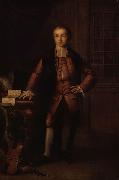 |
Thomas Frye
|
|
The Anglo-Irish painter Thomas Frye (c. 1710 - 3 April 1762 best known for his portraits in oil and pastel, including some miniatures and his early mezzotint engravings, was also the patentee of the Bow porcelain factory, London, and claimed in his epitaph to be "the inventor and first manufacturer of porcelain in England," though his rivals at the Chelsea porcelain factory seem to have preceded him in bringing wares to market. The Bow porcelain works did not long survive Frye's death; their final auctions took place in May 1764.
Thomas Frye was born at Edenderry, County Offaly, Ireland, in 1710; in his youth he went to London to practice as an artist. His earliest work are a pair of pastel portraits of boys, one dated 1734 (Earl of Iveagh). For the Worshipful Company of Saddlers he painted a full-length portrait of Frederick, Prince of Wales (1736, destroyed 1940), which he engraved in mezzotint and published in 1741. With his silent partner, a London merchant Edward Heylyn, he took out a patent on kaolin to be imported from the English colony of Virginia in November 1745, and became manager of the Bow factory from its obscure beginnings in the 1740s. He retired to Wales in 1759 for the sake of his lungs, but soon returned to London and resumed his occupation as an engraver, publishing the series of life-size fancy portraits in mezzotint, by which he is most remembered. He died of consumption on 2 April 1762.
Frye had five children; his two daughters assisted him in painting porcelain at Bow until their marriages. One of them, who married a Mr. Willcox, was employed by Josiah Wedgwood at the Wedgwood Etruria works in painting figure-subjects from 1759 to 1776, the year of her death. |
|
|
|
|
|
|
|
|
|
|
|
|
|
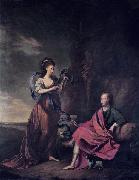 |
Thomas Hickey
|
|
was an Irish painter.
Born in Dublin, Hickey was the son of Noah, a confectioner in Capel Street, and Anne Hickey. A younger brother was John Hickey, the sculptor. He was trained at the Royal Dublin Society schools under Robert West.
Hickey painted primarily portraits and genre scenes. He traveled widely, working in India, Portugal, Italy and England, residing in Bath between 1776 and 1780. On his voyage to India, the vessel in which he was travelling was captured by French and Spanish fleets which led him to Lisbon, where, after receiving a number of commissions, he remained for several years. He eventually reached Bengal and stayed there until 1791 when he returned to England. He then traveled as far as Peking, China with George Macartney, 1st Earl Macartney as the expedition's official portrait painter.
He returned to Ireland shortly after the death of his brother John in January 1796. In 1797, he was commissioned by Dr. Robert Emmet, State Physician for Ireland, to paint a portrait of the doctor's son, Robert, and daughter, Mary. By 1798 he had returned to India where he landed just in time for the start of the Fourth Mysore War, which kept him engaged in painting. He resided in Madras until his death in 1824.
In addition to his artistic talents, he is reputed to have been a sparkling conversationalist who rarely failed to charm his sitters. The Courtauld Institute of Art (London), the Honolulu Academy of Arts, the National Gallery of Ireland, the Tate and the Victoria Art Gallery (Bath, England) are among the public collections having paintings by Thomas Hickey. |
|
|
|
|
|
|
|
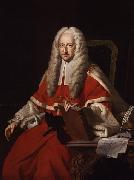 |
Thomas Hudson
|
|
Thomas Hudson (1701 - 1779) was an English portrait painter in the 18th century. He was born in 1701 in the West Country of the United Kingdom. His exact birthplace is unknown. Hudson studied under Jonathan Richardson in London and against his wishes, married Richardson's daughter at some point before 1725.
Hudson was most prolific between 1740 and 1760 and, from 1745 until 1755 was the most successful London portraitist. He lived at Deep Cross, Twickenham.
Many assistants were employed by Hudson, to help with his paintings. Joshua Reynolds and Joseph Wright were students of Hudson. He retired toward the end of the 1750s. |
|
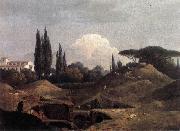 |
Thomas Jones
|
|
Thomas Jones (26 September 1742 - 29 April 1803) was a British landscape painter. He was a pupil of Richard Wilson and was best known in his lifetime as a painter of Welsh and Italian landscapes in the style of his master. However, Jones's reputation grew in the 20th century when more unconventional works by him, ones not been intended for public consumption, came to light. Most notable among these is a series of views of Naples which he painted from 1782 to 1783. By breaking with the conventions of classical landscape painting in favour of direct observation, they look forward to the work of Camille Corot and the Barbizon School in the 19th century. His autobiography, Memoirs of Thomas Jones of Penkerrig, went unpublished until 1951 but is now recognised as a major work of commentary on the 18th-century art world. |
|
|
|
 |
Thomas Kennington
|
|
(7 April 1856 - 10 December 1916) was an English genre, social realist and portrait painter. He was a founder member of the New English Art Club (NEAC) and the Imperial Arts League.
Kennington was born in Grimsby in Lincolnshire and trained in art at the Liverpool School of Art (winning a gold medal), the Royal College of Art (RCA) in London, and the Academie Julien in Paris, where he studied under Bougereau and Robert-Fleury. He later moved to Chelsea in London.
He exhibited at the Royal Academy, London from 1880 - 1916, and also regularly showed his work at the Royal Society of British Artists (RBA) in Suffolk Street and the Grosvenor gallery. He was a founder member and first secretary of the New English Art Club (from 1886), and also founded the Imperial Arts League, whose stated purpose was to "protect and promote the interests of Artists and to inform, advise and assist...."He won a bronze medal at the Exposition Universelle of 1889.
cjr |
|
|
|
|
|
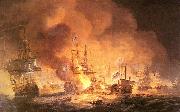 |
Thomas Luny
|
|
(1759-1837), born in Cornwall, probably at St Ewe, was an English artist and painter, mostly of seascapes and other marine-based works. At the age of eleven, Luny left Cornwall to live in London. There he became the apprentice of Francis Holman, a marine painter who would have a great and long lasting artistic influence on Luny: Luny remained until 1780 in Holman's London studio, which, was first situated in Broad Street, St. George, and later relocated to Old Gravel Lane.
In September 1777, Luny left Holman's studio for a while, to journey to France. During this particular expedition, Luny almost certainly strayed from France itself; his first exhibited picture in London, seen at the Society of Artists that same year, was given the title A distant view of the island of Madeira and Porto Santo, suggesting that an engraving had inspired his choice of subject. Similarly, it is unlikely that Luny was on hand for the Battle of the Nile, 1798, and the bombardment of Algiers, 1816, both of which he illustrated with dramatic atmosphere and credible realism.
After leaving Holman's studio in 1780, Luny moved to Leadenhall Street during 1783. It was around this time that Luny was frequently exhibiting at the Royal Academy, in a total of twenty-nine exhibitions between 1780 and 1802. In Leadenhall Street, Luny became acquainted with a "Mr. Merle", a dealer and framer of paintings who promoted Luny's paintings for over twenty years, to great success. Luny also found a wealthy source of business in Leadenhall Street, where the British East India Company had their headquarters; their officers commissioned many paintings and portraits from Luny. This relationship between the Company and Luny also had several non-monetary benefits for Luny; it seems probable that, considering the great detail and realistic look of many of his sketches of locations such as Naples, Gibraltar, and Charleston, South Carolina, Luny was occasionally invited as a guest on the Company's ships on special occasions and voyages. |
|
|
|
 |
thomas malton
|
|
Thomas Malton (1748 - 7 March 1804), the younger, was an English painter of topographical and architectural views, and an engraver. J M W Turner and Thomas Girtin were amongst his pupils. He is designated the younger to differentiate him from his father Thomas Malton the elder.
Malton was born in London, the son of Thomas Malton the elder, a notable architectural draughtsman and writer on geometry. He was with his father during the latter's residence in Dublin, Ireland, and then passed three years in the office of James Gandon the architect, in London. In 1774 Malton received a premium from the Society of Arts. He entered the Royal Academy and in 1782 gained a gold medal for his design for a theatre. In 1773 he sent the Academy a view of Covent Garden, and was afterwards a constant exhibitor, chiefly of views of London streets and buildings, drawn in Indian ink and tinted. In these there is little attempt at pictorial effect, but their extreme accuracy in the architectural details renders them of great interest and value as topographical records. They are enlivened with groups of figures, in which Malton is said to have been assisted by Francis Wheatley.
After leaving Ireland, Malton appears to have always lived in London - with the exception of a brief stay at Bath in 1780. From 1783 to 1789 he resided in Conduit Street (London), and at an evening drawing class which he held there, received as pupils Thomas Girtin and young J M W Turner, whose father brought him to be taught perspective. Turner paid tribute to him in later life by saying My real master was Tom Malton.
In 1791 Malton removed to Great Titchfield Street, and finally, in 1796, to Long Acre. He made a few of the drawings for Watts's Seats of the Nobility and Gentry published in 1779, and executed some large aquatints of buildings in both London and Bath, being one of the first to avail himself of the newly introduced art of aquatinta for the purpose of multiplying copies of his views. He also painted some scenes for Covent Garden Theatre.
In 1792 Malton published the work by which he is now best known, A Picturesque Tour through the Cities of London and Westminster, illustrated with a hundred aquatint plates. Between 1798 -1800 he produced Views from Cambridge, and at the time of his death was engaged upon a similar series of views of Oxford, some of which appeared in parts in 1802, and were reissued with others in 1810.
Malton died in Long Acre, London on 7 March 1804, leaving a widow and six children. His portrait, painted by Gilbert Stuart, was engraved by William Barney in 1806. A portrait of his son Charles, when a child, drawn by Sir Thomas Lawrence, was engraved by F C Lewis.
Malton's brother James Malton was also a notable artist, draughtsman and engraver. |
|
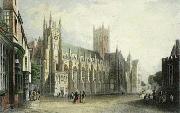 |
Thomas Mann Baynes
|
|
(1794 ?C 1876) was a London born English artist known for his drawings and watercolours of landscapes, buildings and outdoor events. Many of his subjects were engraved and published, generally in London, and these include a notable panorama of the River Thames, which was drawn from nature and engraved on stone. He was the son of James Baynes, a noted watercolour artist.
Baynes also produced views of Liverpool and Ireland, and appears to have made a successful living as a printer prior to his death in 1854. His son Fredrick Thomas Baynes (1824-1874) was also a noted watercolour artist.
|
|
|
|
|
|
|
|
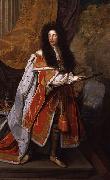 |
Thomas Murray
|
|
Wikipedia does not have an article with this exact name. Please search for Thomas Murray (artist) in Wikipedia to check for alternative titles or spellings. |
|
|
|
|
|
|
|
 |
Thomas Phillips
|
|
(18 October 1770 - 20 April 1845) was a leading English portrait and subject painter. He painted many of the great men of the day including scientists, artists, writers, poets and explorers.
Phillips was born at Dudley then in Worcestershire. Having acquired the art of glass-painting in Birmingham under Francis Eginton,[1] he visited London in 1790 with an introduction to Benjamin West, who found him employment on the painted-glass windows of St George's Chapel at Windsor. In 1791, he became a student of the Royal Academy, and exhibited there, in 1792, a view of Windsor Castle, followed in the next two years by the "Death of Talbot, Earl of Shrewsbury, at the Battle of Castillon," "Ruth and Naomi," "Elijah restoring the Widow's Son," "Cupid disarmed by Euphrosyne," and other pictures.
After 1796, he mainly confined himself to portrait-painting. However, the field was very crowded with the likes of John Hoppner, William Owen, Thomas Lawrence and Martin Archer Shee competing for business; consequently, from 1796 to 1800, his exhibited works were chiefly portraits of gentlemen and ladies, often nameless in the catalogue and of no great importance historically-speaking.
|
|
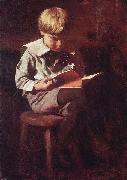 |
Thomas Pollock Anshutz
|
|
(1851-1912) was an American painter and teacher.
He studied art at the National Academy of Design in New York City, and moved to Philadelphia in 1875 to study under Thomas Eakins at the Philadelphia Sketch Club. He entered the Pennsylvania Academy of the Fine Arts in 1876, becoming Eakins's assistant there in 1878, and his successor in 1886. He later studied in Paris at the Academie Julian, 1892-93 |
|
|
|
|
|
|
|
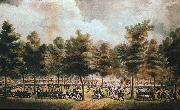 |
Thomas Ruckle
|
|
was a house painter and sign painter in early nineteenth century Baltimore, Maryland, and an amateur painter. He is best known for his paintings The Battle of North Point, and The Defense of Baltimore. Ruckle was a veteran of the War of 1812, in which he had served as a corporal in the 5th Maryland Regiment of the Maryland Militia.
Ruckle was born in Ireland and, having moved to Baltimore, Maryland, he became a sign painter and house painter. It is likely that he had very little, if any, formal training as an artist. |
|
|
|
|







